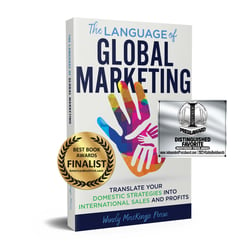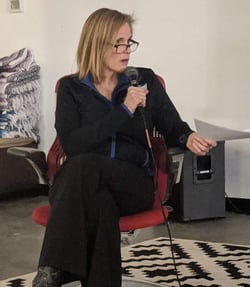Glossary of Translation and Interpretation Terms and Phrases
The “language” of translation – Get the most out of your project by familiarizing yourself with the common terms and phrases used by translation and interpreting service providers.

Everything you need to know to understand the key terms of the language industry.
Industry jargon can be confusing to an outsider. Here we’ve put together a glossary of language service industry terms and expressions to help you develop a deeper understanding of the information you’ll encounter while browsing our website or speaking to one of our specialists.
If you have questions about Rapport International or any of the terms or processes, please contact us by using the form below.
AI Translation - Also known as Artificial Intelligence translation, refers to the process of using artificial intelligence (AI) technologies, particularly machine learning and natural language processing (NLP) algorithms, to automatically translate text or speech from one language to another. While AI translation has made advancements in providing quick and accessible translations, it’s important to note that, as of now, it still has limitations in accurately capturing the full context, nuances, and cultural subtleties present in human-generated translations. For critical or sensitive content, human professional translators are preferred. See also Machine Translation and Neural Machine Translation. Learn more about AI Translation.
Certified translation – A professional translation that is accompanied by a signed, notarized statement from the translator or translation company affirming accuracy and completeness of the information. Certified translations are often required for legal or official documents. Learn more about certified translations.
Conference Interpreting – See Simultaneous Interpreting.
Consecutive Interpreting – The conversion of speech from source to target language in a conversational setting. The participants speak in segments, pausing to allow the interpreter to convey the message in another language. Learn more about consecutive interpreting.
Cultural Adaptation – The process of modifying, adjusting, or tailoring communications to suit the cultural preferences, norms, values, and expectations of a specific target audience or to acknowledge and honor differing cultural contexts. See also Localization. Learn more about the benefits of cultural adaptation for business growth.
Gist Translation – Refers to the process of conveying the main or general meaning of text or speech from one language to another, rather than providing a complete, high-quality translation. We often refer to AI and machine translation as appropriate only for “gist translations,” due to the prevalence of errors and a complete lack of cultural understanding. When accuracy is paramount, human translation is still the best option. Learn more about machine and AI translation.
Globalization – The use of language to communicate with speakers around the world. Globalized language is not localized or culturally adapted for a specific country or region.
High-Quality Translation – Translation done by a professional human translator. To maintain quality for important documents, you need an experienced human translator. In-house personnel may not have the experience or specific localization knowledge to deliver the quality you need. Learn more about high-quality translation and about avoiding risks and liability by using high-quality translation services.
Human Translator or Interpreter – Skilled bilingual, native-speaking language service professionals who convert written (translation) and spoken (interpreting) communications from a source language to a target language. Human translators and interpreters have knowledge and experience in the subject matter and can guarantee 100% accuracy, unlike automated tools.
Interpreting – The conversion of spoken communication from one language to another. Learn more about interpreting services.
Language Pair – Term used to define the source-to-target language combination. For example, for text that is being converted from Spanish to English, the language pair would be Spanish-English or sp-en.
Localization –The process of modifying, adjusting, or tailoring communications to suit the cultural preferences, norms, values, and expectations of a specific target audience or to acknowledge and honor differing cultural contexts. See also Cultural Adaptation. Learn more about localization for marketing materials.
Machine-Aided Translation – Tools to help human translators work accurately and quickly. Most are terminology databases and translation memories. Examples include Trados, DejaVu, Wordfast, Transit, and SDLX.
Machine Translation (MT) – The translation of text from one language to another by computer without human intervention. The process relies on a computer’s capacity to analyze the structure of a statement and translate the elements into the same structure in another language. Basic machine translation tools are good for providing “gist” translations. See also AI Translation and Neural Machine Translation.
Native Language or Mother Tongue – The first language learned at home that is still understood and practiced.
Native Speaker – A native speaker is a person who has spoken a language from age 5 or earlier and possesses a “normal” or typical regional accent. Native speakers will also be most familiar with the dialects, culture, and customs crucial to precise and respectful translation and interpreting services.
Neural Machine Translation (NMT) – a state-of-the-art approach to machine translation that employs neural networks, a type of artificial intelligence, to translate text from one language to another. Unlike traditional statistical methods used in machine translation, NMT operates based on deep learning techniques. While NMT has made advancements in providing better translations than its predecessors, it’s important to note that, as of now, it still has limitations in accurately capturing the full context, nuances, and cultural subtleties present in human-generated translations. For critical or sensitive content, human translators are preferred. See also AI Translation and Machine Translation. Learn more about AI Translation.
Proofreading – Reviewing translated content to correct errors in grammar, syntax, or terminology. Learn more about proofreading.
Simultaneous Interpreting – The conversion of speech from source to target language in a group setting. The interpreter actively interprets while the speaker delivers their speech or presentation. Also referred to as Conference Interpreting. Learn more about simultaneous interpreting.
Source Language – The original language of a document, web page, or email before it is translated.
Subtitling – The addition of written text to a video or film, used to translate spoken dialogue or to convey information in another language. Learn more about subtitling and multimedia translation options.
Target Language – The language into which the written translation or spoken interpreting is converted.
Transcreation – Adapting brand content to inspire cultural relevance within a new market while keeping messaging, style, context, and intent consistent. Standard translation may not sufficiently communicate an equivalent emotional intent in other cultures and languages.
Transcription – Converting spoken language into written text, often used as a preliminary step in translation, subtitling, or for accessibility purposes.
Translation – The transformation of the written word from one language to another. Often used as an “umbrella term” for globalization, localization, transcreation, etc. Learn more about translation.
Translation Glossary – A client-specific database of terms collected during translation projects, used as a reference in future projects with similar terminology and phraseology to guarantee consistency.
Translation Memory (TMS) – Software that automates the storage of matching source and target language segments for future use. TMS records are kept for each client and provide future cost- and time-saving opportunities by consolidating commonly used terms and phrasing.
Voice-Over or Dubbing – Recording information in a different language to replace the original voice in audio or video content. Learn more about voice-over and multimedia translation options.
Website Translation –Translation of web pages to inform and attract visitors who speak other languages. Studies show that internet users prefer to visit and shop with companies who present website information in their native language. Learn more about website translation.
Contact Us
Learn more about Rapport International and the services we offer




